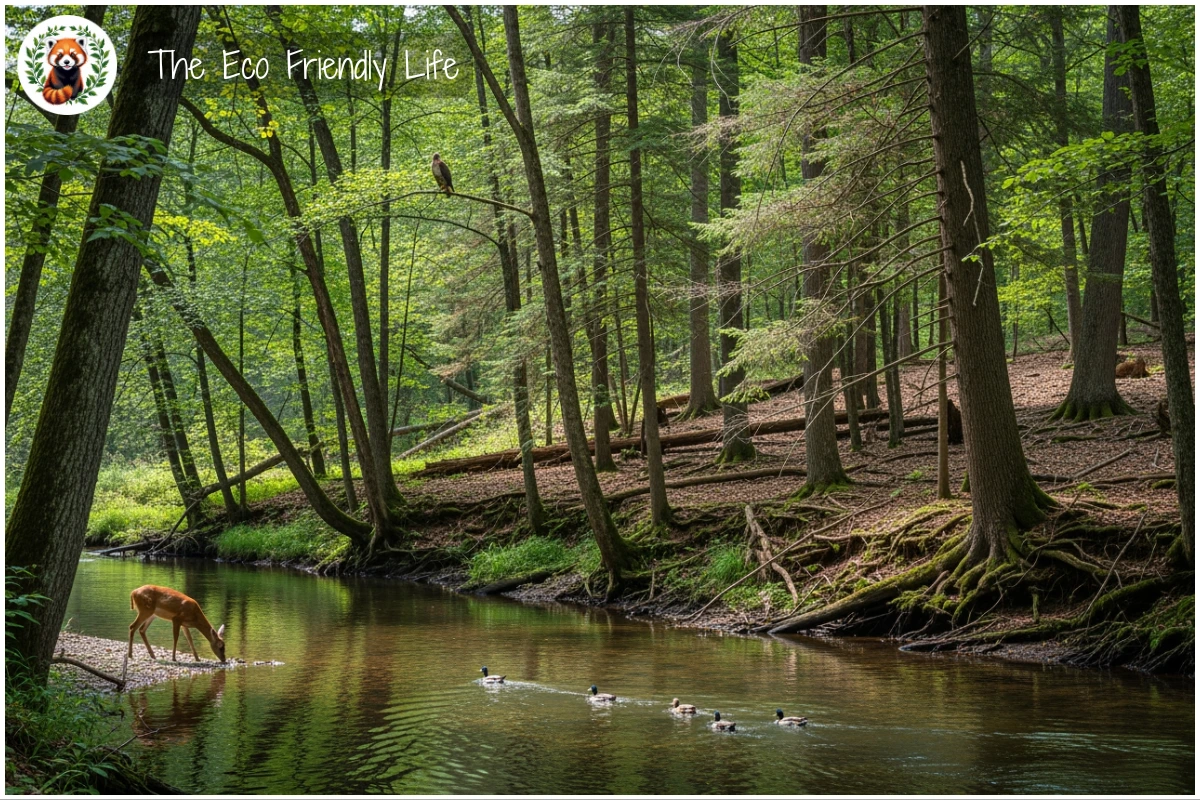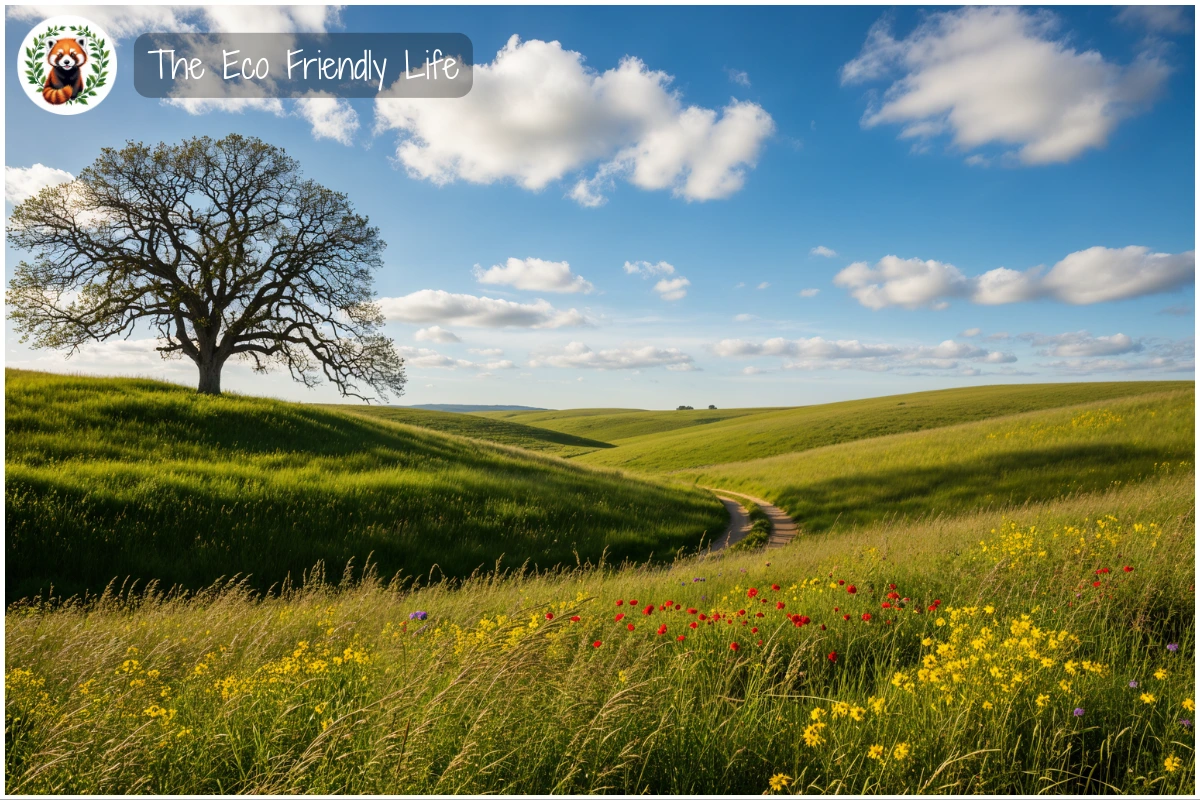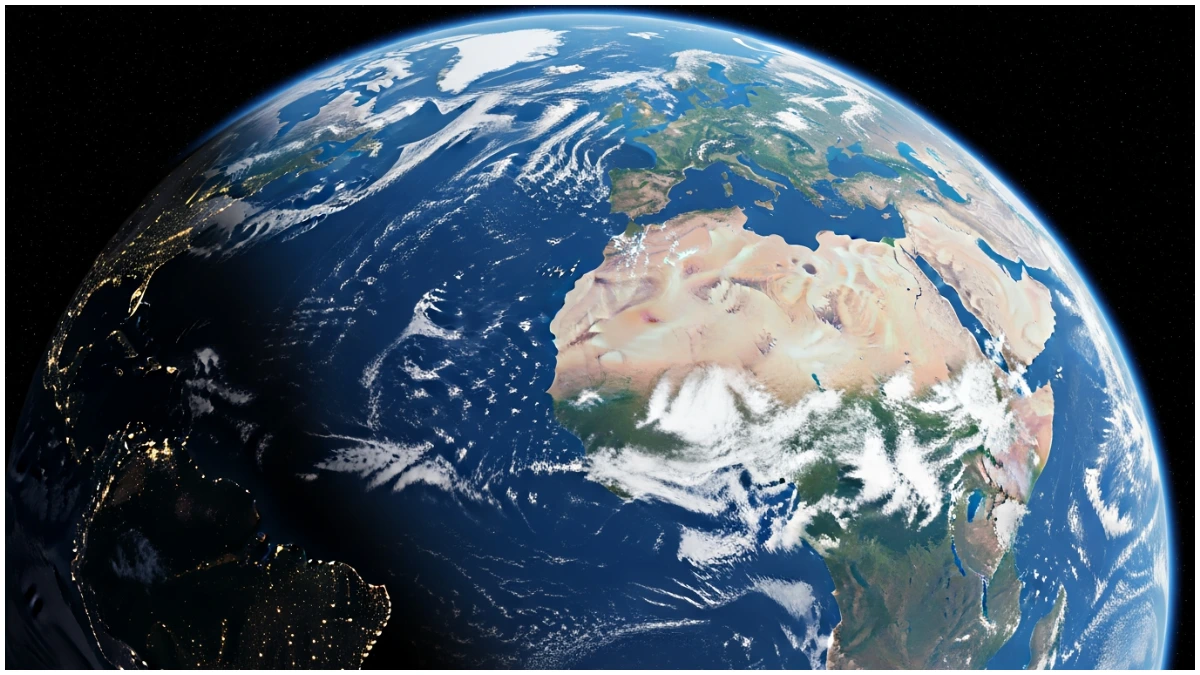Understanding the language of environmental science is the first step toward becoming an informed planetary citizen. Whether you’re hearing about climate policies on the news, reading product labels at the store, or simply wanting to engage in meaningful conversations about our shared future, knowing these fundamental terms empowers you to take action.
I’m Al, and I’m passionate about making environmental education accessible to everyone, everywhere. Throughout my work, I’ve seen how understanding just a few key concepts can transform someone from a passive observer into an active participant in protecting our planet. Continue reading to discover the essential vocabulary that will help you navigate environmental issues and make choices that matter for the world we all share.
Understanding Core Environmental Concepts
Climate Change: This term describes a long-term shift in global weather patterns or average temperatures, typically persisting for decades or longer. While Earth has experienced natural climate variations throughout its history, current warming is occurring at an unprecedented rate due to human activities like burning fossil fuels and clearing forests. Rising temperatures affect weather patterns globally, causing more frequent extreme events like droughts, floods, and heatwaves that impact communities from coastal cities to mountain villages.
Biodiversity: The Convention on Biological Diversity defines this as the variability among living organisms from all sources including terrestrial, marine and other aquatic ecosystems and the ecological complexes of which they are part. It encompasses three critical levels: diversity within species, between species, and of ecosystems. Biodiversity underpins everything we depend on for survival, from the food we eat to the medicines that heal us, making its preservation essential for human wellbeing across all continents.
Carbon Footprint: This measures the emissions of greenhouse gases, especially carbon dioxide and methane, produced by an individual, organization, product, or practice. Your carbon footprint includes emissions from driving your car, heating your home, the products you purchase, and even the food you eat. Understanding your footprint helps identify where you can make the most significant reductions in your environmental impact and supports your journey toward becoming carbon neutral.
Greenhouse Gases (GHGs): These are gaseous constituents of the atmosphere that absorb and emit radiation, causing the greenhouse effect. The primary greenhouse gases include carbon dioxide, methane, and nitrous oxide. While some greenhouse effect is natural and necessary for life, excessive greenhouse gas concentrations from human activities trap too much heat in the atmosphere, causing global warming.
Ecosystem: An ecosystem consists of all the living organisms in a particular area interacting with each other and their non-living environment. From a small pond to a vast rainforest, ecosystems support life through intricate relationships between plants, animals, microorganisms, soil, water, and air. When one component changes, it affects the entire system, highlighting how interconnected our natural world truly is and why protecting ecosystems maintains biodiversity.

These foundational terms provide the building blocks for understanding more complex environmental issues. With these concepts established, we can now explore how human activities either sustain or deplete our planet’s resources.
Sustainability and Resource Management
Sustainability: This principle means meeting the needs of the present without compromising the ability of future generations to meet their own needs. Sustainability involves maintaining a balance of resources extracted and resources restored across three interdependent pillars: economic sustainability including job creation, environmental sustainability focusing on water quality and reduction of greenhouse gas emissions, and social sustainability including environmental justice and human health. Sustainable practices consider the long-term consequences of our actions, ensuring that the planet’s resources remain available for your children and their children.
Renewable Energy: These are energy sources derived from naturally replenished resources such as sunlight, wind, water, and plant matter. Unlike fossil fuels that take millions of years to form, renewable energy sources regenerate on human timescales. Solar energy, wind power, hydroelectric power, geothermal energy, and biomass provide clean alternatives that reduce greenhouse gas emissions. Transitioning to renewable energy supports decarbonisation efforts by reducing the proportion of electricity generated by fossil fuels.
Conservation: This refers to the careful preservation and protection of something, especially the planned management of a natural resource to prevent exploitation, destruction, or neglect. Conservation encompasses protecting wildlife habitats, managing forests sustainably, preserving water resources, and maintaining biodiversity through nature-based solutions that protect ecosystems. Every action you take to conserve resources, whether switching off lights or supporting protected areas, contributes to safeguarding Earth’s natural heritage.
Circular Economy: This system is designed to keep products in circulation to the fullest extent possible by streamlining production processes, reusing, repairing and recycling materials to reduce waste. Rather than the traditional linear model of take-make-dispose, a circular economy mimics natural cycles where waste becomes a resource for something new, creating closed loops that minimize environmental impact.
Carbon Neutral: Organizations or individuals that are carbon neutral achieve net-zero carbon emissions by balancing carbon dioxide emissions produced by human activities with carbon absorption or removal from the atmosphere. Achieving carbon neutrality requires reducing emissions as much as possible and offsetting remaining emissions through carbon removal projects like reforestation or carbon capture technologies.

These resource-focused terms help you understand how human activities can either deplete or sustain our planet’s finite natural resources. Now let’s examine the atmospheric processes that drive climate change and what terms describe these critical phenomena.
Climate and Atmospheric Terms
Global Warming: This refers to the increase in global surface temperature relative to pre-industrial baseline periods. The IPCC documents that warming is unequivocal and primarily caused by human activities. Since pre-industrial times, Earth’s average temperature has risen significantly, with most warming occurring in recent decades. This warming drives numerous environmental changes including melting ice caps, rising sea levels, and altered weather patterns affecting communities worldwide.
Deforestation: This describes the clearing or removal of forests on a large scale, typically for agriculture, logging, or urban development. Forests are home to more than 80 percent of all terrestrial species of animals, plants and insects. The loss of trees contributes to climate change as forests act as carbon sinks, absorbing carbon dioxide from the atmosphere. Beyond climate impacts, deforestation destroys habitat for wildlife, disrupts water cycles, increases soil erosion, and reduces biodiversity.
Carbon Sequestration: This process draws carbon out of the atmosphere and stores it in a carbon pool or sink where greenhouse gases are stored, such as in soils, plants, trees, and oceans. Carbon sequestration occurs naturally in Earth’s carbon cycle but can be enhanced by humans through planting trees, carbon capture and storage (separating carbon from industrial sources), or supporting nature-based solutions that strengthen ecosystems.
Net-Zero: This represents the overall balance between emitting and absorbing carbon in the atmosphere. The outcome of limiting catastrophic climate change requires companies and countries to become net-zero by reducing greenhouse gas emissions to nearly zero and offsetting remaining emissions. Many policies are based on achieving net-zero within certain timeframes.
Emissions: When we use the term emissions, we refer to the greenhouse gases released into the atmosphere produced by human-related activities such as burning fossil fuels, transportation, and industrial processes. Understanding emissions scope matters: Scope 1 refers to direct emissions from sources owned by an organization, Scope 2 refers to indirect emissions from purchased electricity and energy, and Scope 3 encompasses all other indirect emissions in the value chain.

Understanding these atmospheric concepts helps explain the mechanisms behind climate change and why reducing emissions through climate change mitigation and transitioning to renewable energy is critical for planetary health. Beyond atmospheric challenges, our daily activities create additional environmental pressures that require practical solutions.
Environmental Challenges and Solutions
Pollution: This encompasses the introduction of harmful substances or contaminants into the natural environment, causing adverse changes to ecosystems, human health, and natural resources. Pollution takes many forms including air pollution from vehicle emissions and industrial processes, water pollution from agricultural runoff and plastic waste, soil contamination from chemicals, and noise pollution affecting wildlife. Addressing pollution requires cleaner technologies, better waste management following the waste hierarchy (prevention, reduction, reuse, recycling, recovery, and disposal), and individual action that reduces your emissions and environmental footprint.
Water Scarcity: This occurs when demand for clean water exceeds available supply. Around 2.2 billion people around the world do not have safely managed drinking water services. Water security—the capacity to safeguard sustainable access to adequate quantities of acceptable quality water—remains a challenge for billions globally. Climate change, population growth, pollution, and inefficient water use all contribute to water scarcity. Water conservation practices, improved infrastructure, sustainable agriculture, and regenerative farming methods can help address this pressing issue affecting communities worldwide.
Organic Farming: This agricultural system emphasizes naturally occurring, non-synthetic inputs such as compost, natural fertilizers, and biological pest control. Organic farming prohibits synthetic pesticides, synthetic fertilizers, and genetically modified organisms. This approach enhances soil fertility, protects biodiversity, conserves water quality, and produces food without harmful chemical residues, benefiting both environmental health and human wellbeing. Supporting organic farming through conscious consumerism and sustainable procurement helps build an agricultural system that regenerates rather than depletes soil health.
Recycling: This process involves collecting and processing materials that would otherwise be discarded as trash and turning them into new products. Recycling reduces the need to extract resources such as timber, water, and minerals while conserving energy. It decreases landfill waste, prevents pollution, and represents a key component of circular economy principles. Recycling one tonne of paper saves emissions equivalent to driving thousands of kilometers, making it a powerful tool for environmental protection accessible to everyone.
Embodied Carbon: Also known as embedded carbon, this includes all the greenhouse gases emitted in producing materials throughout their entire lifecycle. It encompasses carbon or GHG emissions associated with manufacturing, transport, and construction practices, reflecting the true environmental cost of products before they even reach consumers. Understanding embodied carbon helps support conscious consumerism and informs sustainable procurement decisions.

These terms help identify environmental problems while highlighting practical solutions that individuals and communities can implement to create positive change. Learning these concepts is valuable, but making real progress requires access to products and resources that support environmental education and sustainable living.
Retailers That Support the Planet – Our Product Recommendations
Educating yourself and others about environmental issues creates ripples of positive change throughout communities. These carefully selected retailers offer resources that deepen environmental knowledge while supporting ethical business practices.
Our Retailer Recommendation for Adults
Bookshop.org – Supporting Independent Bookstores and Environmental Learning
This online bookshop supports local independent bookstores while offering an extensive collection of environmental literature. Bookshop.org’s environmental book collections include titles on climate action, sustainability, and nature connection, making complex environmental topics accessible for all ages. Consider exploring their environmental reads to find the perfect book that explains climate science, inspires conservation action, or connects you more deeply with nature.
Our Retailer Recommendation for Kids/Families
Green Kid Crafts – Sustainable STEAM Education for Young Learners
Founded by environmental scientist and mother Penny Bauder, this subscription service delivers hands-on STEAM activities designed to spark a lifelong love of learning while fostering environmental awareness. Each Green Kid Crafts box contains educator-designed science and art projects using sustainable materials, teaching children about ecosystems, renewable energy, and conservation through creative play. Their rainforest, solar system, and nature-themed boxes help families explore environmental topics in engaging, age-appropriate ways that align perfectly with the concepts in this guide.
These retailers demonstrate how purchasing decisions can align with environmental values while expanding knowledge and inspiring action in your household. Beyond learning about these issues, taking concrete daily action transforms knowledge into meaningful impact.
Practical Daily Tips You Can Action Today
Small changes in daily habits accumulate into significant environmental impact when practiced consistently by millions of people worldwide.
| Tip | How to Implement | How It Helps |
|---|---|---|
| Reduce single-use plastics | Carry reusable bags, bottles, and containers; refuse plastic straws and utensils | Decreases plastic pollution in oceans and landfills; reduces petroleum consumption and embodied carbon in plastic production |
| Conserve water at home | Take shorter showers; fix leaks; turn off taps while brushing teeth or washing dishes | Preserves freshwater resources and supports water security; reduces energy needed for water treatment and heating |
| Choose energy-efficient appliances | Look for energy ratings when purchasing; unplug devices when not in use; support renewable energy | Lowers electricity consumption and greenhouse gas emissions from power generation; supports decarbonisation |
| Support local and seasonal food | Shop at farmers markets; choose produce grown in your region; support organic farming | Reduces transportation emissions; supports regenerative agriculture and circular economy principles |
| Reduce food waste | Plan meals; store food properly; compost organic waste following waste hierarchy principles | Decreases methane emissions from landfills; conserves resources used in food production; supports circular economy |
| Walk, cycle, or use public transport | Plan trips to combine errands; explore car-sharing options; work from home when possible | Reduces air pollution and carbon emissions from personal vehicles; lowers your carbon footprint |
| Practice conscious consumption | Buy only what you need; choose quality over quantity; repair instead of replace; practice sustainable procurement | Decreases demand for resource extraction; reduces manufacturing emissions, embodied carbon, and waste |
| Plant native species and support regenerative practices | Create a garden with local plants; support community regenerative agriculture initiatives | Provides habitat for local wildlife; supports biodiversity; requires less water and maintenance than exotic species |
| Educate yourself and others on sustainability | Read environmental news; share knowledge with family and friends; participate in community discussions | Builds awareness; creates ripples of change through informed decision-making; supports environmental justice |
| Support environmental organizations | Donate to conservation causes; volunteer for local environmental groups; advocate for climate change mitigation | Amplifies impact through collective action; funds research and protection initiatives; advances conservation goals |
These accessible actions empower you to contribute meaningfully to environmental protection and climate action regardless of where you live or your circumstances. As you implement these daily practices, questions naturally arise about environmental challenges and solutions.
FAQs
Here are answers to common questions about environmental terms and concepts.
What’s the difference between climate change and global warming? Global warming specifically refers to the rise in Earth’s average surface temperature, while climate change encompasses broader changes including altered precipitation patterns, extreme weather events, and shifting seasons caused by this warming.
How does biodiversity affect my daily life? Biodiversity provides essential ecosystem services you use every day including pollination of food crops, natural water filtration, medicine sources, climate regulation through carbon sequestration, and the decomposition of waste materials that maintain healthy ecosystems.
Can individual actions really make a difference? Absolutely! Individual choices create market demand for sustainable and organic products, influence corporate practices toward conscious capitalism, inspire others through example, and collectively contribute to measurable reductions in resource consumption, emissions, and environmental footprints.
Why is water scarcity a problem even in areas with rainfall? Water scarcity and poor water security can result from pollution making water unsafe, lack of infrastructure to collect and distribute it, seasonal variations in availability, or excessive use that depletes groundwater faster than natural replenishment occurs.
Organizations to Support – Our Recommendations
These globally recognized organizations work tirelessly to address environmental challenges through science-based conservation, community empowerment, and systemic change supporting net-zero targets and biodiversity protection.
- World Wildlife Fund (WWF) is the world’s largest conservation organization, working in more than 100 countries and supporting around 3,000 conservation and environmental projects. The organization protects endangered species and habitats while working to conserve biodiversity and reduce humanity’s ecological footprint. Support their mission through donations to WWF that fund on-ground conservation programs protecting wildlife and supporting nature-positive outcomes.
- Rainforest Alliance works in 78 nations to conserve forests and improve lives of farmers through sustainable agriculture certification and landscape restoration projects. With over 7.9 million farmers and workers on certified farms globally, they bring farmers, forest communities, companies, and consumers together to create a better world for people and nature. Donate to the Rainforest Alliance to support their work addressing climate crisis and deforestation while empowering rural communities.
- Conservation International has protected 13 million square kilometers across more than 70 countries since 1987, focusing on climate solutions, forest restoration, and marine conservation through nature-based solutions. Your gift funds urgent conservation work, helping them move quickly to protect the places that need it most. Support Conservation International to fund important conservation work used where needed most.
These organizations demonstrate proven track records of environmental impact and offer transparent pathways for supporting their vital work in climate change mitigation and biodiversity conservation. To deepen your understanding beyond these organizational resources, several expert sources provide comprehensive environmental education materials.
Resources and Further Reading
These authoritative sources provide deeper understanding of environmental science, policy, and solutions based on rigorous research and data.
- United Nations Environment Programme (UNEP) is the leading global environmental authority that sets the global environmental agenda and promotes the coherent implementation of the environmental dimension of sustainable development. UNEP offers comprehensive resources on climate action, biodiversity conservation, and pollution reduction. Access UNEP’s environmental programs for evidence-based information on global environmental issues and sustainable development goals.
- NASA Climate Change Resources provides decades of Earth observation data, climate modeling, and educational materials about how we monitor planetary changes from space. From the unique vantage point in space, NASA collects critical long-term observations of our changing planet. Explore NASA’s Climate Change website for satellite imagery, temperature records, and scientific explanations accessible to all audiences.
- National Geographic Environment delivers award-winning journalism on environmental challenges and solutions through compelling stories, photography, and educational materials. Their coverage explores the world’s environmental issues through stories on groundbreaking research and inspiring individuals making a difference for our planet. Visit National Geographic’s Environment section for in-depth articles and resources.
These trusted sources ensure you have access to accurate, current information for making informed decisions about environmental issues, emissions reduction, and supporting organizations advancing net-zero and conservation goals.
Our Related Articles

How We Can Help The Environment
The environmental challenges facing our planet today are more urgent than ever before. From climate change and biodiversity loss to pollution and resource depletion, the…
Read More
Climate Change: Causes, Effects And Solutions
The planet we call home is sending us urgent signals. From unprecedented heatwaves scorching cities to devastating floods reshaping coastlines, climate change has moved from…
Read MoreConclusion
Environmental terminology forms the foundation for understanding and addressing the planetary challenges we face together. From climate change and biodiversity to sustainability, renewable energy, carbon sequestration, and the circular economy, these terms equip you with the language to participate meaningfully in environmental discussions, make informed consumer choices through conscious consumerism, and take effective action in your community supporting conservation and climate change mitigation.
The journey toward environmental stewardship begins with understanding but continues through daily action aligned with nature-positive principles and sustainable practices. Whether you start by reducing your carbon footprint, supporting regenerative agriculture, choosing renewable energy, advocating for conservation, or sharing knowledge with others, every step contributes to the collective effort needed to achieve net-zero emissions and protect our shared home.
What environmental term resonated most with you, and which action will you commit to implementing first in your daily life to support sustainability and reduce your environmental footprint? Share your thoughts and experiences in the comments below—your insights might inspire someone else to take their first step toward environmental awareness and action.


